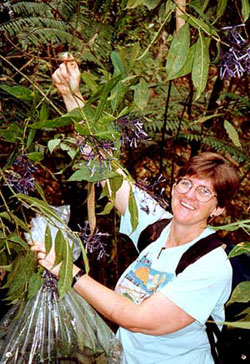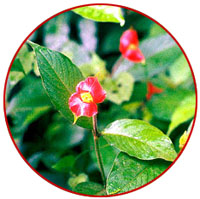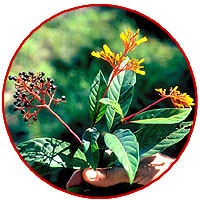 |
QUICK SEARCH
MO PROJECTS:
Africa
Asia/Pacific
Mesoamerica
North America
South America
General Taxonomy
Photo Essays
Training in Latin
America
MO RESEARCH:
Wm. L. Brown Center
Bryology
GIS
Graduate Studies
Research Experiences
for Undergraduates
Imaging Lab
Library
MBG Press
Publications
Climate Change
Catalog Fossil Plants
MO DATABASES:
W³MOST
Image Index
Rare Books
Angiosperm
Phylogeny
Res Botanica
All Databases
INFORMATION:
What's New?
People at MO
Visitor's Guide
Herbarium
Jobs & Fellowships
Symposium
Research Links
Site Map
Search
 | table of contents |
PROFILE: Charlotte M. Taylor | |||||||
 |
Associate curator Charlotte Taylor studies Rubiaceae for Flora Mesoamericana, Flora of the Venezuelan Guayana, Flora of North America, a checklist for Bolivia, and floras for regions of Ecuador, Colombia, Brazil, and Madagascar. She has 67 scientific publications to her credit and has described 120 new species.
Photo: Dorothy Bay |
||||||
All in the FamilyIf they're members of Rubiaceae, the coffee family, they've come to the right place. The fifth largest family of flowering plants, Rubiaceae is Taylor's specialty. But the family still holds many secrets, which explains the yellow stick-ons: Taylor estimates that as many as one in three species of Rubiaceae remain to be discovered. She's working on that. Taylor devotes much of her considerable energy to examining specimens sent to her for identification. Her renown in the field parallels that of many of her colleagues at the Garden. "Nothing is more fundamental than plant identification. This is where the botanical information pyramid begins, and we're known for our expertise in this area," she says. "This is not a quick and easy job. We do it an an extremely detailed level." Taylor, like many of her Garden colleagues, contributes prolifically to botanical science through many media, including scientific publications, symposia and databases. An important component of this process is the botanical monograph. "Monographs shed light on similarities among species, where they live and how they may have migrated from one area to another," Taylor explains. "A monograph pulls the facts together into a story, offering a relational view of members of a family." The information also feeds into evolutionary, ecological and genetic studies conducted by scientists in other disciplines. "Monographs help us draw inferences about how species live together, how communities form, and how many species are needed to make a viable community," she adds. "In the end, though, I think what we mostly learn from our work is how much remains to be learned about our planet." | |||||||
| |||||||
Next Section >> | |||||||
| Text and photos from "The Unseen Garden" available from MBG Press. | |||||||
© 1995-2025 Missouri Botanical Garden, All Rights Reserved
4344 Shaw Blvd.
St. Louis, MO 63110
(314) 577-5100
Technical Support

